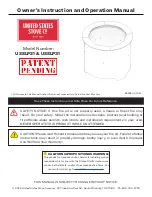
15
11 – Fault Finding
Fire will not burn
The fuel is too wet and not suitable
Air inlets to the stove are blocked
The flue is blocked or restricted
Inadequate air supply into the room
Soot build up on glass
Fuel is too wet
Fuel pieces are too large and “smouldering” rather than burning.
The stove operating temperature is too low
The stove is being run too “slow” with not enough air
Poor
chimney
draft
Too little secondary air washing over the window
Excessive wear on internal parts
Stove fired too vigorously
Too little air passing through the bottom grate
Use of wood that is too dry (eg wood from old furniture)
12 – Spare Parts
A full range of products are available to maintain your stove including :-
Rope
Rope Glue
Glass cleaner
Stove paint
All individual components of the hobbit are available as spares.
For the complete list of available spares with prices go to Salamanderstoves.co.uk
16
CE Plate


























